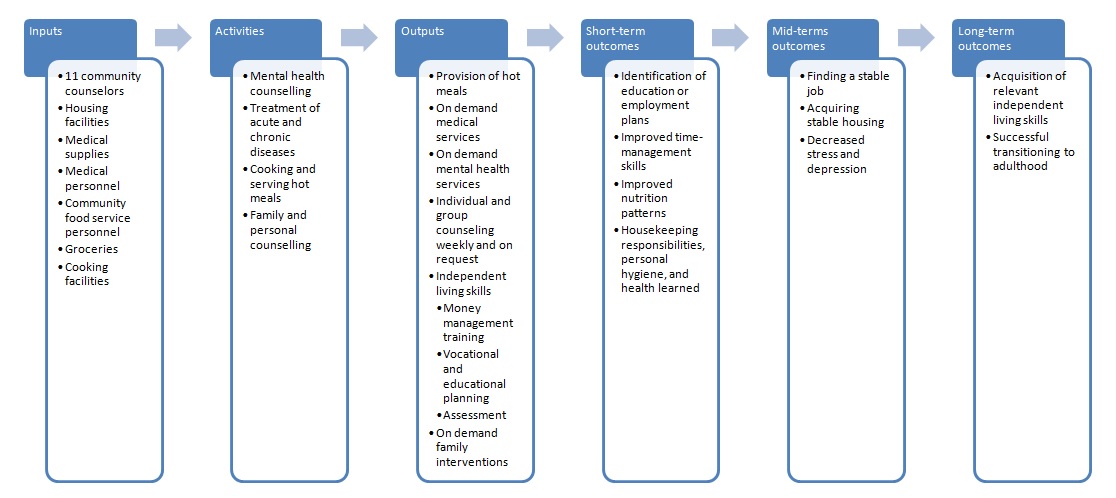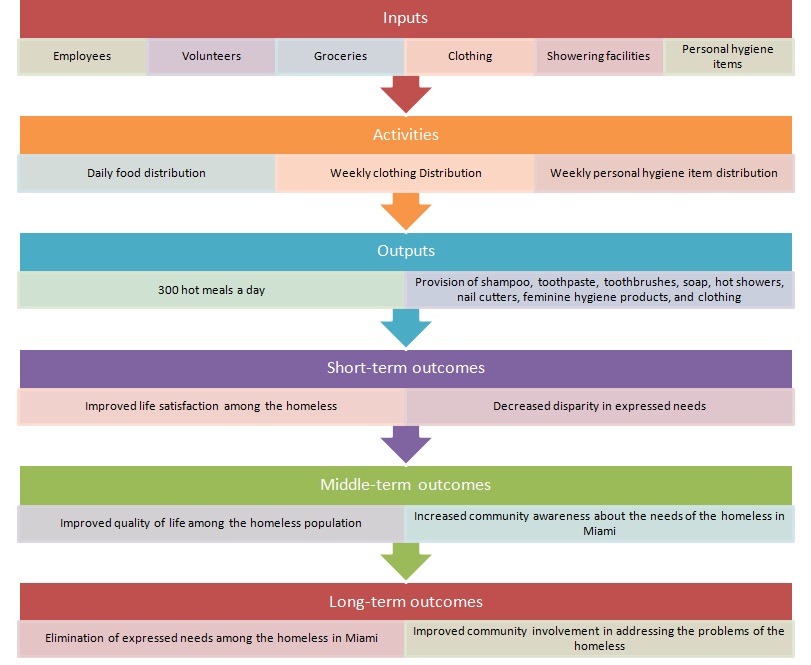Logic Model
An introduction of a logic model for a program is crucial for getting a clear grasp of a program’s theory. According to Savaya and Waysman (2005), a graphical representation of the theory is vital for successful program execution and evaluation. Programs are often complex, comprising many different interconnected constituencies. A logic model can help to conceptualize the matter to help the stakeholders understand it. Figure 1 is an example of a logic model designed for a transitional living program for homeless adolescents described by Giffords, Alonso, and Bell (2007).

Final Project
Supporting the homeless population is of the central tasks for human services in the United States and globally. Even though the number of homeless people in Miami-Dade County is slowly decreasing, the problem requires additional attention. According to Homeless Trust (2019), there are more than 3,600 homeless people in the county, among which 35% are male, 46% have a disability, and 25% have no source of income. Currently, the population is served by the Homeless Trust and Feeding South Florida program. The Homeless Trust organizes and directs the Miami-Dade County Homeless Plan, which is a central document of the county that regulates the government policy that addresses the issues of the homeless (Homeless Trust, n.d.). Feeding South Florida provides hot meals to people facing food insecurity, among which are homeless people (Feeding South Florida, n.d.). Additional attention is needed to the issue of homelessness to decrease the number of homeless population. The present paper offers a design of a human service program in Miami that offers hot meals and shower facilities for the homeless.
Needs Assessment
The importance of understanding the precise needs of populations during the development of a program hypothesis and plan is self-evident. According to Grant (2002), needs assessment is a vital stage of program planning that ensures positive changes in practice. Methods offered by Giffords, Alonso, and Bell (2007), will be used for the needs assessment, including structured interviews and questionnaires. Below are the examples of questions of the needs assessment survey:
- How many times a week do you have a hot meal?
- Are you aware of any services available to homeless people in Miami?
- What are your most immediate needs?
The answers to question 1 and 2 will provide quantitative data, while question 3 will accumulate qualitative information. The answers to the three questions will enable the evaluator to conduct a mixed-method analysis, which is vital for ensuring the credibility of the findings (Duffy & Chenail, 2009). During the needs procedure, volunteers will ask these three questions to homeless people in Miami urban area. The volunteers will write down the answers and give them to the project manager for further evaluation. After that, designated employees will conduct several structured interviews with random representatives of the population to ensure the objectivity of the assessment results.
The needs of the homeless may differ depending on geographical location, age, and gender. In Miami, the normative needs are adequate sheltering, affordable housing, and stable income (Bernstein, 2017). The comparative needs are psychological and career counseling (Bernstein, 2017). The felt needs include stability and companionship, while the expressed needs are food, clothing, and personal hygiene items (Lowenstein, 2019). Even though needs seem evident, a careful needs assessment is needed to confirm the preliminary suppositions.
Program Design
The program offers to target the homeless population in Miami to address the issue of food insecurity. Homeless people will be offered hot meals and personal hygiene items on demand. The program will also provide clean and warm clothing and the opportunity to have a shower. The mission of the program is to satisfy the expressed needs of the homeless population in Miami. The goals are to ensure nutrition stability, provide a sufficient amount of personal hygiene items, allow on-demand access to showering facilities, and assure that all the homeless have appropriate clothing for the season. Figure 1 represents the logic model for the proposed program.

Even though the program has a limited impact on the community since it addresses only the expressed needs of the homeless population. However, it can still have a positive impact on the community and contribute to social change. The program will gather the majority of homeless people in one place, which will help address the population to provide or collect information. According to D’Arcy (2018), when urban people see the size of the problem and become more compassionate and attentive to the needs of the homeless. Additionally, homeless people will be provided with the chance to change their lifestyle, since a good meal, hot shower, and neat clothing can help to get a job.
Program Evaluation
The program will be evaluated in three stages. First, questionnaires will be handed out to the target population to assess the satisfaction with the provided services and determine the aspects of the program that were most helpful. Second, the number of provided services will be estimated and juxtaposed with the expenses to evaluate the cost-efficiency of the program. Third, the local community will be interviewed to understand if the program had an impact on society and change their views. In the process of program assessment, it is expected that qualitative and quantitative data will be acquired to make changes needed to improve the outcomes.
References
Bernstein, D. (2017). A crackdown on the poor and hungry. The Homeless Voice. Web.
Feeding South Florida. (n.d.). About us. Web.
D’Arcy, P. (2018). How food — yes, food — can be a tool for social change. We Humans. Web.
Giffords, E. D., Alonso, C., & Bell, R. (2007). A transitional living program for homeless adolescents: A case study. Child & Youth Care Forum, 36(4), 141–151. Web.
Grant, J. (2002). Learning needs assessment: assessing the need. BMJ, 324(7330), 156-159. Web.
Duffy, M., & Chenail, R. J. (2009). Values in qualitative and quantitative research. Counseling and Values, 53(1), 22-38.
Homeless Trust. (2019). Affordable housing critical to maintaining downward trend of street homelessness in Miami-Dade County. Web.
Homeless Trust. (n.d.). About the Homeless Trust. Web.
Lowenstein, B. (2019). The homeless woman’s monthly struggle: Periods. The Homeless Voice. Web.
Savaya, R., & Waysman, M. (2005). The logic model. Administration in Social Work, 29(2), 85–103.